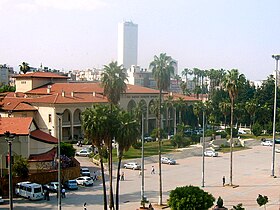Bourg de 12 000 habitants aujourd'hui , en plein coeur d'Anatolie, entouré de petites montagnes. Nous roulons sur les routes arides d'Anatolie , à 1800 m d'altitude, en venant de SIVAS (SEBASTIA) DU NORD : soudain une tache verte, une oasis GURUN .
PLUS BAS : La GrANDE RUE bordée par la rivière LA RIVIERE TOHMAK qui coupe le village en 2.
Des rues à l'habitat traditionnel rénové. Belles maisons avec l'avancée du 1er étage d'où les femmes regardent la rue.
"L'été il faisait si chaud que nous couchions sur le toît au milieu des abricots qui sèchaient au soleil."
Au nord l'habitat est dispersé; petit centre-ville avec une mosquée et une église à moitié détruite mais impressionnante .(massacres sous Abdul Hamid , le "sultan rouge" )
Un "Guruntsi" transforme Gürün en filiale des entreprises de Manchester .ds centaines de métiers à tisser sont répartis dans les familles guruniennes & celles des villages environnants.
La région, en altitude, a des pâturages pour l'élévage du mouton , développé par les Kurdes et les Turkmènes. L'agriculture rest pauvre et donc l'émigration est importante. La ville profite donc de ces migrants , commerçants originaires de Gürün, qui viennent acheter les produits locaux, et vendre ou échanger les textiles de Damas , Halep (Alep)et Rize contre dela laine brute.
Dans les années 1830 les artisans se spécialisent dans la teinture des Indiennent qu'ils importent , les teignent en bleu et les réexportent.
En 1880 il y a 500 métiers à tisser : châles, , pantalons et vestes en laine et aussi des tissu légers , imitation du cashmire , des copies d'échantillons de vêtemnts pour l'Inde, la Perse et l'Europe.
En 1907 les textiles sont vendus à Dyarbékir (Dikranaguerd) et en 1910 sur les marchés egyptiens
On mélange déjà le coton à la laine.
En 1911 il y a 3500 métiers à tisser à Gurun et les villages, : un centre de production principal de la province de Sivas….
gurun / tegarama en assyrien,/ targkhigamas en ourartéen, ancêtres des Hays;
sources : Michel Pazoumian / Le livre de ma famile (Karayan / Baghtchedjian / etc…)
"Manufacturing in the Ottoman Empire and Turkey 1500-1950 Donald Quataert State University of New-York"
—————————————————————————————————————————–
Gurün is a town in Sivas Province of Turkey. It is the seat of Gürün District.[2] Its population is 10,657 (2022).[1] The mayor is Nami Çiftçi (MHP).
History
Toponymy
The current name Gürün is most probably a corruption of the ancient name Tegarama, a city in Anatolia during the Bronze Age.[citation needed] In Armenian, the town is known as Gurin or Gyurin (Armenian: Կիւրին). In Kurdish the locality is known as Girîn.[3]
Ancient history
The city was inhabited during the Old Assyrian Kingdom and Hittite Empire. Ancient rock caves dating to 2000 BC are located in the district. The caves would have been in use, possibly as a kind of apartment complex, during the Hittite period. The caves were also "used as a cold storage area, woodshed and animal feed storage area by local people until a short time ago", and are now open to visitors.[4] Nami Çiftçi, the town's mayor, told Daily Sabah that they "don't have a precise date determined by expert engineers or by people who are well-versed in this field, so I invite our historians to Gürün. Come, bring your knowledge and your tools, study these caves so that we can have the data regarding their age, and we can announce it to the world".[5]
Modern history
During the Armenian Genocide, a sizable portion of the city's Armenian population was deported and killed. According to the memoir Goodbye, Antoura, during the pre-genocide years the Armenian population had achieved a level of stability in Gürün, with at least one Armenian family owning large swathes of land and orchards. In 1915, the Ottoman government appropriated these lands, and the Armenian population was deported southward and westward into the Syrian desert, eventually reaching the cities of Homs and Hama.[6]
A student association of Armenians from Gürün was founded in Boston in 1899, which later became the Compatriotic Union of Gurin. The union's initial purpose was to assist survivors of the genocide and their families, and it established chapters across the world. The compatriotic union published two periodicals, one from 1930 to 1933 in New York and another from 1976 to 1981 in New Jersey, as well as a book titled Badmakirk' Gurini ("History Book of Gurin", 1974, Beirut). The union cooperated with Armenians from Gürün in Yerevan to found the village of Nor Kyurin in Soviet Armenia. The organization was dissolved in the late 20th century, as the last Armenians born in Gürün died of old age.[7]
In September 2018, it was announced that a dilapidated Armenian church in Gürün would be renovated.[8][9]
Demographics
In his Seyahatname, Evliya Çelebi claimed that the town's population then was wholly made up of Turkomans.[10] In 1914, there were 13,874 Armenians living in the kaza of Gürün, which contained five villages that were exclusively Armenian and a few scattered settlements. Gürün, the kaza's seat, had 12,168 residents, 8,406 of whom were Armenian.[11]
Notable people
- Antranig Dzarugian (1913–1989), Armenian writer, poet, educator and journalist
- Haroutiun Galentz (1910–1967), Armenian painter
- Abdüllatif Şener (born 1954), Turkish politician
- Mustafa Karasu (born 1950), a deputy chairman of the Kurdistan Workers' Party (PKK)
- Vahe Vahian (1909–1998), Armenian poet, writer, editor, pedagogue and orator
- İsmet Yılmaz (born 1961), Turkish politician
- Cem Yılmaz (born 1973), Turkish comedian
References
- ^ Jump up to:a b "Address-based population registration system (ADNKS) results dated 31 December 2022, Favorite Reports" (XLS). TÜİK. Retrieved 22 May 2023.
- ^ İlçe Belediyesi, Turkey Civil Administration Departments Inventory. Retrieved 22 May 2023.
- ^ Avcýkýran, Dr. Adem (ed.). "Kürtçe Anamnez, Anamneza bi Kurmancî" (PDF). Tirsik. p. 57. Archived from the original (PDF) on 6 June 2020. Retrieved 17 September 2022.
- ^ Datta, Debasish (2021-03-26), "Optical Local/Metropolitan and Storage-Area Networks", Optical Networks, Oxford University Press, pp. 135–160, doi:10.1093/oso/9780198834229.003.0003, ISBN 978-0198834229, retrieved 2021-09-21
- ^ SABAH, DAILY (2020-12-09). "4,000-year-old apartment complex in central Turkey awaits researchers, tourists". Daily Sabah. Retrieved 2021-09-21.
- ^ "Chapter 8. Goodbye, Antoura", Goodbye, Antoura, Stanford University Press, pp. 144–166, 2020-12-31, doi:10.1515/9780804796347-010, ISBN 9780804796347, S2CID 242755866, retrieved 2022-02-19
- ^ Baronian, Luc Vartan. "The Former Armenian Community of Gurin". www.uqac.ca. Retrieved 2022-05-12.
- ^ "Պիտի վերանորոգուի Սեբաստիոյ պատմական եկեղեցին". arevelk.am (in Armenian). 2018-09-27. Retrieved 2022-05-12.
- ^ Aghjayan, George (2019-06-27). "The Many Lives of a Church in Gurin". The Armenian Weekly. Retrieved 2022-05-12.
- ^ Evliyâ Çelebi Seyahatnâmesi: III. p. 201. Retrieved 17 October 2022.
Cümle âhâlîsi Okçıoğlu kürkü geyer Türkmân kavmidir.
- ^ Kévorkian, Raymond H. (2011). The Armenian genocide: a complete history. London: I.B. Tauris. p. 446. ISBN 9780857719300.








